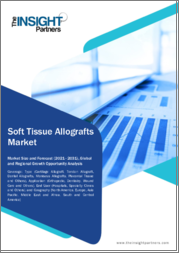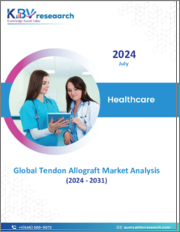
|
시장보고서
상품코드
1691777
골이식편 시장 - 세계 산업 규모, 점유율, 동향, 기회, 예측, 용도별, 유형별, 최종사용자별, 지역별 부문, 경쟁(2020-2030년)Bone Allografts Market- Global Industry Size, Share, Trends, Opportunity, and Forecast, Segmented By Application, By Type, By End-user, By Region & Competition, 2020-2030F |
||||||
골이식편 세계 시장 규모는 2024년 14억 5,000만 달러로 평가되었고, 예측 기간 동안 2030년까지 연평균 7.25%의 괄목할 만한 성장이 예상됩니다.
골이식편 세계 시장은 고령화 인구 증가, 정형외과 질환 증가, 의료기술의 발전 등을 배경으로 최근 큰 폭으로 성장하고 있습니다. 골이식편은 공여자의 뼈 조직을 수혜자에게 이식하는 것으로, 정형외과 및 치과 수술의 중요한 부분으로 자리 잡았습니다. 골이식편은 다양한 정형외과적 및 치과적 용도에 사용되는 인간 공여자의 조직 이식임베디드니다. 주로 뼈 결손, 골절, 척추 고정, 관절 재건, 치과 치료 등의 수술에 사용됩니다. 골이식편은 자가골 이식(환자 자신의 몸에서 채취한 뼈 조직)을 대체할 수 있는 대안으로 뼈의 치유를 촉진하고 통증과 회복 시간을 단축하는 능력으로 인기를 얻고 있으며, 2024년 기사에 따르면 영국 75-84세 인구의 약 63%가 근골격계 질환을 앓고 있다고 합니다. 이는 전 연령대에서 가장 높은 유병률입니다. 전반적으로 근골격계 질환의 유병률은 연령에 따라 증가하는 경향이 있으며, 노인 인구에 큰 영향을 미칩니다는 점을 강조하고 있습니다.
| 시장 개요 | |
|---|---|
| 예측 기간 | 2026-2030년 |
| 시장 규모 : 2024년 | 14억 5,000만 달러 |
| 시장 규모 : 2030년 | 21억 9,000만 달러 |
| CAGR : 2025-2030년 | 7.25% |
| 급성장 부문 | 탈회골 기질 |
| 최대 시장 | 북미 |
골관절염, 골절, 척추 변형과 같은 정형외과 질환의 전 세계 유병률은 증가하는 추세입니다. 이러한 추세는 골이식편에 대한 수요를 촉진하고 있습니다. 골이식편은 이러한 질환을 치료하기 위한 외과적 개입에 있어 매우 중요한 역할을 하기 때문입니다. 최소 침습 수술 및 로봇 보조 수술과 같은 수술 기술의 발전으로 골이식편의 채택이 증가하고 있습니다. 이러한 기술들은 뼈 이식술의 정확성과 유효성을 높이고 있습니다. 고령화 사회는 골다공증, 퇴행성 관절 질환 등 노화에 따른 뼈 문제를 겪기 쉽습니다. 노인 인구는 지속적으로 증가하고 있으며, 골이식편에 대한 수요는 크게 증가할 것으로 예상됩니다. 조직 이식을 규제하는 엄격한 프레임워크로 인해 골이식편의 안전성과 품질이 향상되고 있습니다. 이는 소비자의 신뢰와 시장 성장을 가속하고 있습니다. 골이식편의 이점에 대한 환자 및 의료 전문가들의 인식이 높아짐에 따라 외과 수술에서 골이식편 이식편의 수용과 활용이 증가하고 있습니다.
주요 시장 성장 촉진요인
근골격계 장애 발생률 증가로 골이식편 세계 시장 성장 주도
주요 시장 이슈
공급망 제약
주요 시장 동향
기술 발전
목차
제1장 개요
제2장 조사 방법
제3장 주요 요약
제4장 고객의 소리
제5장 세계의 골이식편 시장 전망
- 시장 규모와 예측
- 금액별
- 시장 점유율과 예측
- 용도별(치과, 척추, 재건 및 외상학, 기타)
- 유형별(동종 피질 골이식, 동종 해면 골이식, 동종 피질 해면 골이식, 탈회골 기질)
- 최종사용자별(병원, 치과의원, 정형외과, 외상센터, 기타)
- 지역별
- 기업별(2024년 시장 주요 5개사 점유율)
- 시장 맵
- 용도별
- 유형별
- 최종사용자별
- 지역별
제6장 북미의 골이식편 시장 전망
- 시장 규모와 예측
- 시장 점유율과 예측
- 미국
- 캐나다
- 멕시코
제7장 유럽의 골이식편 시장 전망
- 시장 규모와 예측
- 시장 점유율과 예측
- 프랑스
- 영국
- 이탈리아
- 독일
- 스페인
제8장 아시아태평양의 골이식편 시장 전망
- 시장 규모와 예측
- 시장 점유율과 예측
- 중국
- 인도
- 일본
- 호주
- 한국
제9장 남미의 골이식편 시장 전망
- 시장 규모와 예측
- 시장 점유율과 예측
- 브라질
- 아르헨티나
- 콜롬비아
제10장 중동 및 아프리카의 골이식편 시장 전망
- 시장 규모와 예측
- 시장 점유율과 예측
- 남아프리카공화국
- 사우디아라비아
- 아랍에미리트(UAE)
제11장 시장 역학
- 성장 촉진요인
- 과제
제12장 시장 동향과 발전
- 최근 동향
- 인수합병(M&A)
- 용도 기동
제13장 경쟁 구도
- Zimmer Biomet inc.
- Medtronic inc.
- Lynch Biologics, LLC
- Biomatlante S.A
- Stryker Corporation
- Royal Biologics, Inc.
- Johnsons & Johnsons
- Smith & Nephew plc
- Baxter International Inc
- Xtant Medical Hldgs.
제14장 전략적 제안
제15장 리서치사에 대해 & 면책사항
LSH 25.04.15The Global Bone Allografts Market was valued at USD 1.45 billion in 2024 and is anticipated to project impressive growth in the forecast period with a CAGR of 7.25% through 2030. The global bone allografts market has witnessed substantial growth in recent years, driven by an increasing aging population, rising cases of orthopedic disorders, and advancements in medical technology. Bone allografts, which involve the transplantation of bone tissue from a donor to a recipient, have become a crucial part of orthopedic and dental procedures. Bone allografts are tissue grafts sourced from a human donor and are used for various orthopedic and dental applications. They are primarily employed in surgeries to treat bone defects, fractures, spinal fusion, joint reconstruction, and dental procedures. Bone allografts serve as a viable alternative to autografts (bone tissue from the patient's own body) and have gained popularity due to their ability to promote bone healing and reduce pain and recovery time. According to a 2024 article, an estimated 63% of individuals aged 75 to 84 in the United Kingdom were living with a musculoskeletal condition, the highest prevalence among all age groups. Overall, the prevalence of musculoskeletal conditions tends to rise with age, highlighting the significant impact on the elderly population.
| Market Overview | |
|---|---|
| Forecast Period | 2026-2030 |
| Market Size 2024 | USD 1.45 Billion |
| Market Size 2030 | USD 2.19 Billion |
| CAGR 2025-2030 | 7.25% |
| Fastest Growing Segment | Demineralized Bone Matrices |
| Largest Market | North America |
The global prevalence of orthopedic disorders, including osteoarthritis, fractures, and spinal deformities, is on the rise. This trend has fueled the demand for bone allografts, as they are crucial in surgical interventions to address these conditions. Technological advancements in surgical techniques, such as minimally invasive surgeries and robotic-assisted procedures, have increased the adoption of bone allografts. These techniques enhance the precision and efficacy of bone grafting procedures. The aging population is prone to age-related bone issues, such as osteoporosis and degenerative joint diseases. As the elderly population continues to grow, the demand for bone allografts is expected to rise significantly. Stringent regulatory frameworks governing tissue transplantation have improved the safety and quality of bone allografts. This has bolstered consumer confidence and market growth. Increased awareness among both patients and healthcare professionals about the benefits of bone allografts has led to higher acceptance and utilization of these grafts in surgical procedures.
Key Market Drivers
Rising Incidence of Musculoskeletal Disorders is Driving the Global Bone Allografts Market
Musculoskeletal disorders have become a significant global health concern, affecting millions of people across the world. These disorders encompass a wide range of conditions that impact the muscles, bones, tendons, ligaments, and other parts of the musculoskeletal system. Conditions like osteoarthritis, osteoporosis, fractures, and spinal disorders have been on the rise due to various factors such as aging populations and sedentary lifestyles. To address the growing demand for musculoskeletal treatments, the global bone allografts market is experiencing remarkable growth.
Musculoskeletal disorders represent a wide spectrum of health issues, and their prevalence is increasing at an alarming rate globally. As the world's population ages, the incidence of musculoskeletal disorders, particularly osteoarthritis and osteoporosis, is rising. Aging leads to a natural loss of bone density and muscle mass, making individuals more susceptible to fractures and joint degeneration. Modern lifestyles often involve extended periods of sitting, limited physical activity, and poor posture. These factors can contribute to muscle imbalances and musculoskeletal problems, including back pain and repetitive strain injuries. Obesity is a significant risk factor for musculoskeletal disorders. Excess weight places additional stress on joints, leading to conditions like osteoarthritis and lower back pain. Jobs that involve repetitive motions, heavy lifting, or prolonged periods of standing can lead to musculoskeletal injuries. Workers in industries like construction, healthcare, and manufacturing are at a higher risk. Participation in sports and physical activities carries a risk of injury, including fractures and ligament tears, which can contribute to the overall burden of musculoskeletal disorders.
Key Market Challenges
Supply Chain Constraints
One of the primary challenges facing the bone allografts market is the consistent and reliable supply of graft materials. The availability of suitable donor tissues can be affected by factors such as changes in regulations, limitations on donor pool size, and disruptions in the supply chain due to natural disasters or health crises like the COVID-19 pandemic. Ensuring a stable supply chain is essential to meet the growing demand for bone allografts.
Key Market Trends
Technological Advancements
Technological advancements have always been a catalyst for innovation and growth in various industries, and the healthcare sector is no exception. In recent years, the global bone allografts market has witnessed a remarkable surge in demand, thanks to the continuous evolution of cutting-edge technologies. Bone allografts, which involve the transplantation of bone tissue from a donor to a recipient, have become a crucial component in various orthopedic and dental procedures. Also, the partnership between two companies leads to the growth of global bone allografts market. For instance, in August 2022, Orthofix Medical Inc., a medical device company, collaborated with CGBio, a developer of synthetic bone grafts, to commercialize and advance the clinical development of Novosis recombinant human bone morphogenetic protein-2 (rhBMP-2) in the U.S. and Canadian markets.
Key Market Players
- Zimmer Biomet inc.
- Medtronic inc.
- Lynch Biologics, LLC
- Biomatlante S.A
- Stryker Corporation
- Royal Biologics, Inc.
- Johnsons & Johnsons
- Smith & Nephew plc
- Baxter International Inc
- Xtant Medical Hldgs.
Report Scope:
In this report, the Global Bone Allografts Market has been segmented into the following categories, in addition to the industry trends which have also been detailed below:
Bone Allografts Market, By Application:
- Dental
- Spine
- Reconstruction & Traumatology
- Others
Bone Allografts Market, By Type:
- Cortical Bone Allografts
- Cancellous Bone Allografts
- Corticocancellous Bone Allografts
- Demineralized bone Matrices
Bone Allografts Market, By End-user:
- Hospitals & Dental Clinics
- Orthopedic & Trauma Centers
- Others
Bone Allografts Market, By Region:
- North America
- United States
- Canada
- Mexico
- Europe
- France
- United Kingdom
- Italy
- Germany
- Spain
- Asia-Pacific
- China
- India
- Japan
- Australia
- South Korea
- South America
- Brazil
- Argentina
- Colombia
- Middle East & Africa
- South Africa
- Saudi Arabia
- UAE
Competitive Landscape
Company Profiles: Detailed analysis of the major companies present in the Global Bone Allografts Market.
Available Customizations:
Global Bone Allografts market report with the given market data, TechSci Research offers customizations according to a company's specific needs. The following customization options are available for the report:
Company Information
- Detailed analysis and profiling of additional market players (up to five).
Table of Contents
1. Product Overview
- 1.1. Market Definition
- 1.2. Scope of the Market
- 1.2.1. Markets Covered
- 1.2.2. Years Considered for Study
- 1.2.3. Key Market Segmentations
2. Research Methodology
- 2.1. Objective of the Study
- 2.2. Baseline Methodology
- 2.3. Key Industry Partners
- 2.4. Major Association and Secondary Sources
- 2.5. Forecasting Methodology
- 2.6. Data Triangulation & Validations
- 2.7. Assumptions and Limitations
3. Executive Summary
- 3.1. Overview of the Market
- 3.2. Overview of Key Market Segmentations
- 3.3. Overview of Key Market Players
- 3.4. Overview of Key Regions/Countries
- 3.5. Overview of Market Drivers, Challenges, Trends
4. Voice of Customer
5. Global Bone Allografts Market Outlook
- 5.1. Market Size & Forecast
- 5.1.1. By Value
- 5.2. Market Share & Forecast
- 5.2.1. By Application (Dental, Spine, Reconstruction & Traumatology, Others)
- 5.2.2. By Type (Cortical Bone Allografts, Cancellous Bone Allografts, Corticocancellous Bone Allografts, Demineralized bone Matrices)
- 5.2.3. By End-user (Hospitals & Dental Clinics, Orthopedic & Trauma Centers, Others)
- 5.2.4. By Region
- 5.2.5. By Company (Shares of Top 5 Market Players, 2024)
- 5.3. Market Map
- 5.3.1. By Application
- 5.3.2. By Type
- 5.3.3. By End user
- 5.3.4. By Region
6. North America Bone Allografts Market Outlook
- 6.1. Market Size & Forecast
- 6.1.1. By Value
- 6.2. Market Share & Forecast
- 6.2.1. By Application
- 6.2.2. By Type
- 6.2.3. By End user
- 6.2.4. By Country
- 6.2.4.1. United States Bone Allografts Market Outlook
- 6.2.4.1.1. Market Size & Forecast
- 6.2.4.1.1.1. By Value
- 6.2.4.1.2. Market Share & Forecast
- 6.2.4.1.2.1. By Application
- 6.2.4.1.2.2. By Type
- 6.2.4.1.2.3. By End user
- 6.2.4.2. Canada Bone Allografts Market Outlook
- 6.2.4.2.1. Market Size & Forecast
- 6.2.4.2.1.1. By Value
- 6.2.4.2.2. Market Share & Forecast
- 6.2.4.2.2.1. By Application
- 6.2.4.2.2.2. By Type
- 6.2.4.2.2.3. By End user
- 6.2.4.3. Mexico Bone Allografts Market Outlook
- 6.2.4.3.1. Market Size & Forecast
- 6.2.4.3.1.1. By Value
- 6.2.4.3.2. Market Share & Forecast
- 6.2.4.3.2.1. By Application
- 6.2.4.3.2.2. By Type
- 6.2.4.3.2.3. By End user
- 6.2.4.1. United States Bone Allografts Market Outlook
7. Europe Bone Allografts Market Outlook
- 7.1. Market Size & Forecast
- 7.1.1. By Value
- 7.2. Market Share & Forecast
- 7.2.1. By Application
- 7.2.2. By Type
- 7.2.3. By End user
- 7.2.4. By Country
- 7.2.4.1. France Bone Allografts Market Outlook
- 7.2.4.1.1. Market Size & Forecast
- 7.2.4.1.1.1. By Value
- 7.2.4.1.2. Market Share & Forecast
- 7.2.4.1.2.1. By Application
- 7.2.4.1.2.2. By Type
- 7.2.4.1.2.3. By End user
- 7.2.4.2. Germany Bone Allografts Market Outlook
- 7.2.4.2.1. Market Size & Forecast
- 7.2.4.2.1.1. By Value
- 7.2.4.2.2. Market Share & Forecast
- 7.2.4.2.2.1. By Application
- 7.2.4.2.2.2. By Type
- 7.2.4.2.2.3. By End user
- 7.2.4.3. United Kingdom Bone Allografts Market Outlook
- 7.2.4.3.1. Market Size & Forecast
- 7.2.4.3.1.1. By Value
- 7.2.4.3.2. Market Share & Forecast
- 7.2.4.3.2.1. By Application
- 7.2.4.3.2.2. By Type
- 7.2.4.3.2.3. By End user
- 7.2.4.4. Italy Bone Allografts Market Outlook
- 7.2.4.4.1. Market Size & Forecast
- 7.2.4.4.1.1. By Value
- 7.2.4.4.2. Market Share & Forecast
- 7.2.4.4.2.1. By Application
- 7.2.4.4.2.2. By Type
- 7.2.4.4.2.3. By End user
- 7.2.4.5. Spain Bone Allografts Market Outlook
- 7.2.4.5.1. Market Size & Forecast
- 7.2.4.5.1.1. By Value
- 7.2.4.5.2. Market Share & Forecast
- 7.2.4.5.2.1. By Application
- 7.2.4.5.2.2. By Type
- 7.2.4.5.2.3. By End user
- 7.2.4.1. France Bone Allografts Market Outlook
8. Asia Pacific Bone Allografts Market Outlook
- 8.1. Market Size & Forecast
- 8.1.1. By Value
- 8.2. Market Share & Forecast
- 8.2.1. By Application
- 8.2.2. By Type
- 8.2.3. By End user
- 8.2.4. By Country
- 8.2.4.1. China Bone Allografts Market Outlook
- 8.2.4.1.1. Market Size & Forecast
- 8.2.4.1.1.1. By Value
- 8.2.4.1.2. Market Share & Forecast
- 8.2.4.1.2.1. By Application
- 8.2.4.1.2.2. By Type
- 8.2.4.1.2.3. By Application
- 8.2.4.2. India Bone Allografts Market Outlook
- 8.2.4.2.1. Market Size & Forecast
- 8.2.4.2.1.1. By Value
- 8.2.4.2.2. Market Share & Forecast
- 8.2.4.2.2.1. By Application
- 8.2.4.2.2.2. By Type
- 8.2.4.2.2.3. By End user
- 8.2.4.3. South Korea Bone Allografts Market Outlook
- 8.2.4.3.1. Market Size & Forecast
- 8.2.4.3.1.1. By Value
- 8.2.4.3.2. Market Share & Forecast
- 8.2.4.3.2.1. By Application
- 8.2.4.3.2.2. By Type
- 8.2.4.3.2.3. By End user
- 8.2.4.4. Japan Bone Allografts Market Outlook
- 8.2.4.4.1. Market Size & Forecast
- 8.2.4.4.1.1. By Value
- 8.2.4.4.2. Market Share & Forecast
- 8.2.4.4.2.1. By Application
- 8.2.4.4.2.2. By Type
- 8.2.4.4.2.3. By End user
- 8.2.4.5. Australia Bone Allografts Market Outlook
- 8.2.4.5.1. Market Size & Forecast
- 8.2.4.5.1.1. By Value
- 8.2.4.5.2. Market Share & Forecast
- 8.2.4.5.2.1. By Application
- 8.2.4.5.2.2. By Type
- 8.2.4.5.2.3. By End user
- 8.2.4.1. China Bone Allografts Market Outlook
9. South America Bone Allografts Market Outlook
- 9.1. Market Size & Forecast
- 9.1.1. By Value
- 9.2. Market Share & Forecast
- 9.2.1. By Application
- 9.2.2. By Type
- 9.2.3. By End user
- 9.2.4. By Country
- 9.2.4.1. Brazil Bone Allografts Market Outlook
- 9.2.4.1.1. Market Size & Forecast
- 9.2.4.1.1.1. By Value
- 9.2.4.1.2. Market Share & Forecast
- 9.2.4.1.2.1. By Application
- 9.2.4.1.2.2. By Type
- 9.2.4.1.2.3. By End user
- 9.2.4.2. Argentina Bone Allografts Market Outlook
- 9.2.4.2.1. Market Size & Forecast
- 9.2.4.2.1.1. By Value
- 9.2.4.2.2. Market Share & Forecast
- 9.2.4.2.2.1. By Application
- 9.2.4.2.2.2. By Type
- 9.2.4.2.2.3. By End user
- 9.2.4.3. Colombia Bone Allografts Market Outlook
- 9.2.4.3.1. Market Size & Forecast
- 9.2.4.3.1.1. By Value
- 9.2.4.3.2. Market Share & Forecast
- 9.2.4.3.2.1. By Application
- 9.2.4.3.2.2. By Type
- 9.2.4.3.2.3. By End user
- 9.2.4.1. Brazil Bone Allografts Market Outlook
10. Middle East & Africa Bone Allografts Market Outlook
- 10.1. Market Size & Forecast
- 10.1.1. By Value
- 10.2. Market Share & Forecast
- 10.2.1. By Application
- 10.2.2. By Type
- 10.2.3. By End user
- 10.2.4. By Country
- 10.2.4.1. South Africa Bone Allografts Market Outlook
- 10.2.4.1.1. Market Size & Forecast
- 10.2.4.1.1.1. By Value
- 10.2.4.1.2. Market Share & Forecast
- 10.2.4.1.2.1. By Application
- 10.2.4.1.2.2. By Type
- 10.2.4.1.2.3. By End user
- 10.2.4.2. Saudi Arabia Bone Allografts Market Outlook
- 10.2.4.2.1. Market Size & Forecast
- 10.2.4.2.1.1. By Value
- 10.2.4.2.2. Market Share & Forecast
- 10.2.4.2.2.1. By Application
- 10.2.4.2.2.2. By Type
- 10.2.4.2.2.3. By End user
- 10.2.4.3. UAE Bone Allografts Market Outlook
- 10.2.4.3.1. Market Size & Forecast
- 10.2.4.3.1.1. By Value
- 10.2.4.3.2. Market Share & Forecast
- 10.2.4.3.2.1. By Application
- 10.2.4.3.2.2. By Type
- 10.2.4.3.2.3. By End user
- 10.2.4.1. South Africa Bone Allografts Market Outlook
11. Market Dynamics
- 11.1. Drivers
- 11.2. Challenges
12. Market Trends & Developments
- 12.1. Recent Development
- 12.2. Mergers & Acquisitions
- 12.3. Application Launches
13. Competitive Landscape
- 13.1. Zimmer Biomet inc.
- 13.2. Medtronic inc.
- 13.3. Lynch Biologics, LLC
- 13.4. Biomatlante S.A
- 13.5. Stryker Corporation
- 13.6. Royal Biologics, Inc.
- 13.7. Johnsons & Johnsons
- 13.8. Smith & Nephew plc
- 13.9. Baxter International Inc
- 13.10. Xtant Medical Hldgs.
14. Strategic Recommendations
15. About us & Disclaimer
(주말 및 공휴일 제외)


















